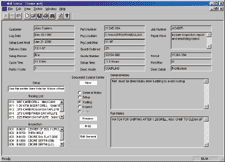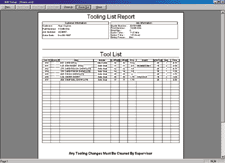Controlling Setup Time Variability In The Small Shop
To be as efficient and effective as possible, all set up data should be clearly and concisely documented. One of the biggest mistakes made today is assuming that the person who set up and engineered the process the first time will be there to do it again.
Share










.png;maxWidth=45)
DMG MORI - Cincinnati
Featured Content
View More
Autodesk, Inc.
Featured Content
View MoreOne of the great time drains in contract manufacturing is the unnecessary reinvention of a machine setup that should have already been proven and debugged. When a job is initially quoted, the cost of the setup is taken into account, but with the current setup documentation practices of many small manufacturers, the setup is more often than not repeated the second time with operators and setup people attempting to either remember the way they did it before or diligently trying to interpret a setup note that made sense previously, but has somehow lost its clarity with time.
When a setup is completed, the data needed to replicate the setup later can be quite extensive. To be as efficient and effective as possible, all of the data, from pickups and tooling data to inspection data and general notes, must be clearly and concisely documented. One of the biggest mistakes made today is assuming that the person who set up and engineered the process the first time will be there to do it again. The fact of the matter is, that in this day and age of high turnover, it is quite likely that another person is going to be digging through handwritten notes and spending more time attempting to decipher a setup than if he or she were to do all over again from the beginning.
Ace Manufacturing (Rochester, New York) was facing just this set of problems when it was introduced to a series of applications designed just for the small shop. When the prospect of controlling and managing the setup process for the shop came its way, the first needs outlined were simplicity, “real world” effectiveness and cost effectiveness. Ace considered many different options once it recognized its need to control the setup process, including everything from Microsoft Word templates to high-end document control packages. The problem that Ace came up against again and again was either underkill or overkill with both of these solutions. The Word templates were just too generic for its needs, and the high end document control packages, while excellent for larger companies with IT departments, did too much and did not address the unique needs of the small shop. What the company needed was an application that attacked its problems and did it in a clean no-nonsense fashion.
During its search Ace came upon timeKillers Software from Chadakoin and its setup documentation software. After seeing one system after another that did “everything,” Ace realized that in the end it only had to accomplish certain tasks to get the job done. Adding more abilities beyond what was necessary to the software had only one result and that was to add complication. With the Chaser applications from timeKillers, Ace was able to save considerable time and money with a minimal investment and a small learning curve. “Before Chaser, we were constantly redoing our setups, figuring out tooling, part datums and generally scratching our heads wondering how it was done the last time,” says Eric Johnson, president of Ace. “And don’t even mention when we have had key people leave; too many times the setup data was in their heads and went out the door with them. Now, I believe it is reasonable of me to expect that the next time we run a part, setting it up is going to be a whole lot less complicated than the first time. Since I can’t control my vendors being late or my machines from breaking down, it means that the things in the shop I can control, I must.” With this software, Ace has one more tool to get jobs done. Now, the biggest problem is not the inability to read illegible notes or wondering why no one left a note, it is deciding how best to refine setups and processes, now that the option is available.
“We do anywhere from ten to 25 setups a week,” says Mr. Johnson, “and if I can save even 15 minutes per setup that’s a savings of $7,800 to $19,500 a year (at a $60 shop rate). For a $200 investment with almost no learning curve for my employees, how could I go wrong?” MMS
Related Content
The Power of Practical Demonstrations and Projects
Practical work has served Bridgerland Technical College both in preparing its current students for manufacturing jobs and in appealing to new generations of potential machinists.
Read More4 Commonly Misapplied CNC Features
Misapplication of these important CNC features will result in wasted time, wasted or duplicated effort and/or wasted material.
Read MoreERP Provides Smooth Pathway to Data Security
With the CMMC data security standards looming, machine shops serving the defense industry can turn to ERP to keep business moving.
Read MoreContinuous Improvement and New Functionality Are the Name of the Game
Mastercam 2025 incorporates big advancements and small — all based on customer feedback and the company’s commitment to keeping its signature product best in class.
Read MoreRead Next
Building Out a Foundation for Student Machinists
Autodesk and Haas have teamed up to produce an introductory course for students that covers the basics of CAD, CAM and CNC while providing them with a portfolio part.
Read MoreRegistration Now Open for the Precision Machining Technology Show (PMTS) 2025
The precision machining industry’s premier event returns to Cleveland, OH, April 1-3.
Read More5 Rules of Thumb for Buying CNC Machine Tools
Use these tips to carefully plan your machine tool purchases and to avoid regretting your decision later.
Read More

















.png;maxWidth=150)


















.jpg;maxWidth=300;quality=90)









